| 1 | South Africa’s main spitting cobra |
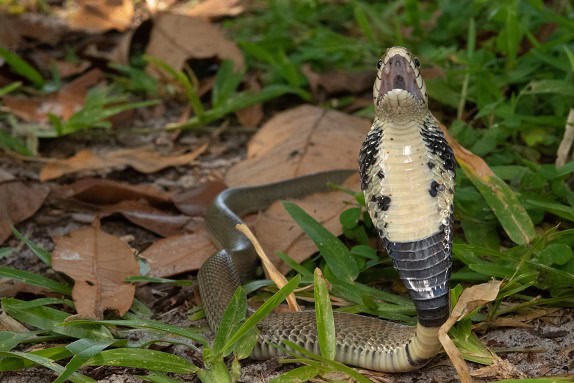
Just as Africa is divided into 54 countries, the continent is further divided into 7 unofficial empires, each of which are controlled by one of Africa’s 7 different spitting cobras. Southeast Africa is home to one of the most feared versions – the Mozambique spitting cobra (Naja mossambica). This species inhabits Botswana, South Africa, Mozambique, Namibia and Zimbabwe, where it’s given the nickname of M’fezi by the Zulu people.
Mozambique spitting cobras are flexible in their habitats, and can pop up almost anywhere. They can inhabit savannahs, open woodlands, plains and rocky hillsides alike, with the only consistent requirement being a source of water nearby.
Their bite can corrode skin and melt through important tendons, but it’s their infamous spitty tendencies which inspire so much fear among local villagers. The Mozambique spitting cobra can fire at a target (usually someone’s eyes) with high accuracy from 2 metres away. The furthest jets can travel 3 metres.
The goal is blinding the target, and this usually wears off after 3 days if the eyes are rinsed, but can sometimes be permanent. Dodging this venom globule is almost impossible unless you have the reactions of a housefly, as each jet travels through the air at 10 miles per hour.
| 2 | Infamous for invading bedrooms |
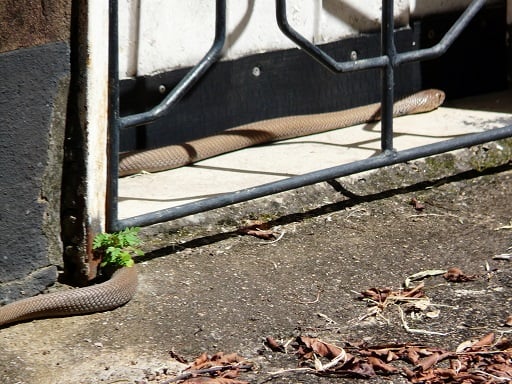
The most terrifying fact about this species isn’t its spraying venom, but its gravitational pull towards human habitation. With boomslangs, there’s little chance of being bitten unless you shake one out of a tree and back it into a corner. Mozambique spitting cobras are notorious for invading people’s bedrooms at the heat of night.
According to a 1982 study, 94% of bites happened inside buildings, and 81% while the victim slept. Most bites happen on the hands or ankles, rather than a strike to the heart of the chest. The common belief is that Naja mossambica seeks out the warmth of the human body, and will bite if the sleeper unconsciously rolls over.
Part of the reason is the species’ nocturnal hunting habits. They sometimes hunt on dim, overcast days, but almost never bright sunny ones. The only real defence is to become nocturnal yourself. It’s one thing to be bitten in a sleeping bag on an isolated camping trail, but Mozambique spitting cobras invade the sanctuary of dreams where everyone thinks they’re safe.
| 3 | Even crawls up toilet pipes |
Mozambique spitting cobras are a rare snake to live up to the age old tale of travelling through houses using the plumbing. In 2019, nightmares almost came true when Juliette Roos lifted her 5 year old daughter off the toilet. In the bowl was the watchful, black-eyed head of a Mozambique spitting cobra, which the girl somehow hadn’t noticed. Juliette screamed for her husband, who dashed in with a shower rail and tried desperately to hook the snake, which nimbly dodged him before disappearing down the toilet pipe from whence it came.
A South African woman wasn’t so lucky in January 2022, when she opened her cupboard door and was instantly sprayed in the eyes. Fortunately, the snake was so shocked that it fell from the clothes wire and into a bucket, a ready made cage which exterminator Nick Evans scooped up when he arrived 5 minutes later.
Golfer John Daly also encountered a Mozambique spitting cobra in 2013, while competing in the Alfred Dunhill Championship in South Africa. The notoriously hard drinking, hard gambling Daly met his match in his hotel room one morning, and was forced to call in an experienced snake exterminator.
| 4 | A mean-faced snake |
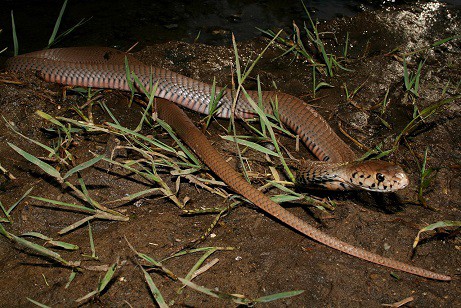
Naja mossambica makes no attempt to disguise its true nature, as its face is particularly cruel looking. Its eyes are jet black and round rather than vertical, but the tops of its eyes are angled downwards, like a pair of eyebrows furrowed downwards in an evil mood of determination to poison.
Side by side, the Mozambique spitting cobra looks far more vicious than the slightly cute forest cobra. There’s no single ID giveaway, but compared to the black-necked spitting cobra, their overall body scales are much paler, with a grey mixed with orange.
Below the chest, a large section of scales has an orange to salmon colour, intermingled with uneven black scales. These pale scales are always richer in colour than the snowy white of the forest cobra. Mozambique spitting cobras are a moderately long species of 0.90-1.05 metres, with the longest on record a mere 1.45m. Their underbellies can be pink, yellow, or even purple, and they have the wide hood of all cobras.
| 5 | Eats black mambas when in the mood |
Naja mossambica doesn’t care about the venom yield of its prey, or venom toxicity ratings calculated in a Harvard University lab. It moves towards whatever it fancies like an unstoppable black hole, and that commonly includes other venomous snakes.
Some of the most amazing images of 2018 showed Naja mossambica swallowing a black mamba, in South Africa’s Marakele National Park. It was like one small pipe slotting into a larger pipe, or a snake spaghetti meal being slowly sucked down. As the images progressed, the snakes twisted and turned, and the black mamba vanished ever further into the cobra’s mouth.
As a family, cobras are particularly prone to preying on smaller snakes. Swallowing a fellow snake’s venom gland is a dangerous business, but cobras have evolved a natural resistance. The pictures proved that Naja mossambica can cope with one of the most notoriously venomous snakes in Africa. They’ve also been witnessed eating puff adders, a thick-bodied lazy serpent which is one of Africa’s most common.
| 6 | Scavenges rotting carcasses |
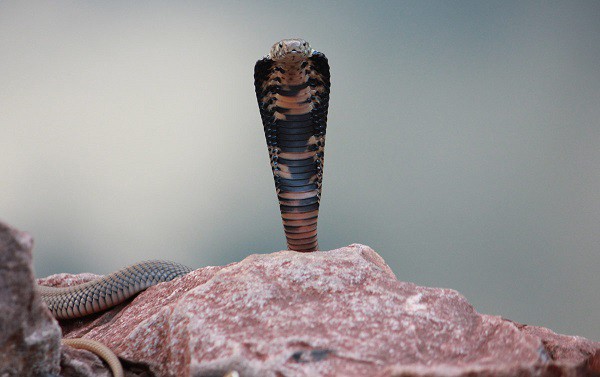
Even the putrid stench of death can’t deter the Mozambique spitting cobra. Scientists crouched in the jungle in 2016 observed the sickening sight of a Naja mossambica approaching a dead Schlegel’s beaked blind snake (Megatyphlops schlegelii), which had been dead for 35 hours and was well into rigor mortis.
The larger snake licked its lips and swallowed the dead snake’s entire body, taking 8 minutes, before slithering off into the jungle while paying the mesmerised scientists no attention. The blind snake was a full three quarters of the spitting cobra’s length.
The Mozambique spitting cobra just eats, eats, eats, and doesn’t care where it gets its biological building blocks from. The only preference they have seems to be toads, particularly the African red toad, a favourite of puff adders as well. This 9cm amphibian also lives in south-east Africa, and has a deep orange back as though sprinkled with cheeto dust. This toad preference is probably why Mozambique spitting cobras need a permanent body of water nearby to survive.
| 7 | Girl makes a miraculous escape |
In February 2018, one nightmare story illustrated all the perils of this cobra in one neat package. 6 year old Mikayla Grove was a resident of Ballito, South Africa, where she shared a bed with her big sister Bella. Her mother Inge was in the dining room when she heard a loud scream. She assumed that Mikayla was having a nightmare, and burst into the darkened room. What she didn’t know was that Mikayla had rolled onto a Mozambique spitting cobra lying comfortably on her mattress.
The snake bit Mikayla on the chin, and its work wasn’t done yet. When mother Inge flicked the light on, the cobra aimed at the door and fired a jet of venom directly into her eyes. Bella rolled away and escaped, and their father Ludwig rushed Inge and Mikayla to the car, with a water bottle in hand to constantly rinse Inge’s eyes, as per an old protocol he had learned. He phoned the emergency unit mid drive, and when Mikayla arrived, she was admitted to intensive care, where she received 17 vials of antivenom.
It took all the doctors’ knowledge to stabilise the small child, and after 4 days she was transferred to a paediatric ward. But there they discovered an infection in her chin, buried below the surface. She also had a hole in her cheek, and the doctors were forced to transfer a flap of tissue from her chin. Ultimately, Mikayla shook off the infection and started her first day at primary school on schedule. The spitting cobra was released back into the wild, but not before the evidently non-vengeful Mikayla had named it Pearl. Meanwhile, her mother Inge kept her sight, all thanks to a plastic water bottle.
| 8 | Corrosive, necrotic venom |
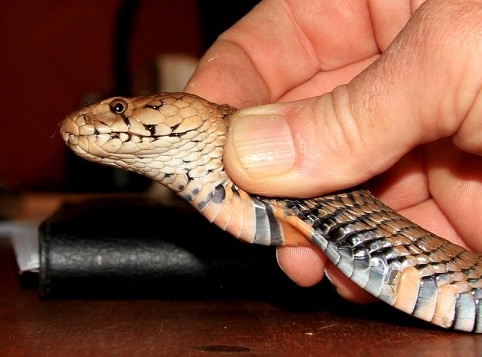
Naja mossambica starts by blinding its enemies, but as usual, it’s the venom injected through fangs which deals the finishing blow.
In humans, there are no common neurotoxic symptoms other than drowsiness. Instead, this is a cytotoxic venom. It’s a venom that corrupts and corrodes the skin, beginning with a dark circular mark around 3 hours post bite. At 9 hours, this circle enlarges and becomes a port wine colour. Fluid oozes from the bite, and as the stain spreads outwards, the colour skips occasionally so that healthy lines are left inbetween.
The worst of the necrosis happens by the 36-48 hour mark, making this a relatively slow acting venom (unlike the Malaysian blue coral snake). This maximum extent is plum coloured, and very clearly demarcated. The necrosis can last for 10 days, with the mean duration being 5 days. Vomiting is also a common symptom of Mozambique spitting cobra bites. Bites rarely kill, but survivors often suffer amputations or disfiguring wounds.
| 9 | Real life examples |
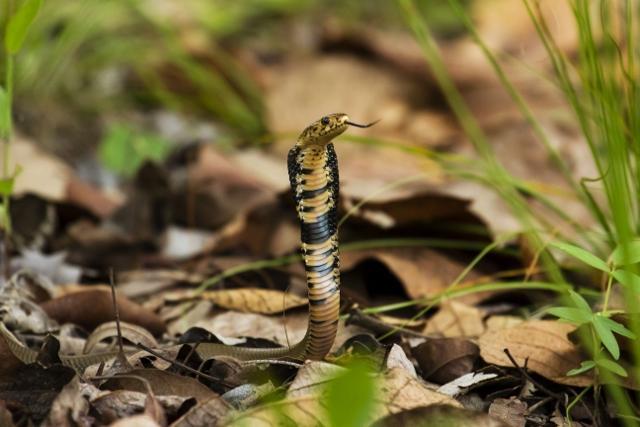
In the 1950s and 60s, many bites from this cobra were falsely attributed to the puff adder. The skin-melting, necrotic nature of the venoms are similar, except that Naja mossambica’s is significantly worse.
One example happened to a 13 year old boy who was bitten multiple times on the neck and fingers while sleeping. He checked into hospital 45 minutes later, experiencing serious breathing difficulties. Doctors pumped him with 8 doses of antivenom, and within 5 hours his lungs were restored to full function.
The problem was the surface-level skin necrosis. As the days progressed, his left little finger and right index finger slowly turned as black as a victim of frostbite, as the phospholipase A2 (the main toxin class) tore through his skin, blocking electron transfer and causing lysis of red blood cells. By day 6, the doctors bowed to the inevitable and both fingers were amputated. The fingers were then shipped off for microbiological analysis.
8 years later, the boy returned for a photoshoot. The wounds had healed well, and he was lucky to have full function in both hands, but he forever bore the scars from the spitting cobra that invaded his bedroom.
| 10 | Twitchy and nervous |
Many of the deadliest snakes are actually docile, but Mozambique spitting cobras are twitchy and nervous. They have the opposite mentality of a Russell’s viper in India, which is extremely nervous yet can even be stepped on by rice farmers without bothering to move. Naja mossambica doesn’t hesitate to bite even if brushed against, and while it usually rears its chest in warning first, a venom-spraying assault can arrive just seconds later. Many walkers have been sprayed from the bushes without realising that they’ve encountered one.
While other snakes default to retreat, Naja mossambica tends to attack just to be safe. It has the ability to spit, and it uses the ability to spit.
Complicating matters is that the Mozambique spitting cobra often plays dead (AKA thanatosis). Walkers might pick up the seemingly empty shell of a snake before being savagely assaulted. According to a South African observation from 2020, the species can play dead for at least 4 minutes without losing patience, with its head tilted sideways on the ground lifelessly.
